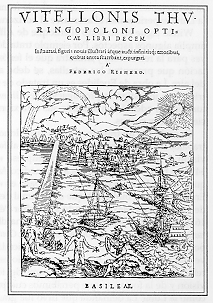Vitello

Vitello (
Name
Vitello's name varies with some sources. In earlier publications he was quoted as Erazmus Ciolek Witelo, Erazm Ciołek, Vitellio and Vitulon. Today, he is usually referred to by his Latin name Vitello Thuringopolonis, often shortened to Vitello.
Life
Vitello's exact birth-name and birthplace are uncertain. He was most likely born around 1230 in
Perspectiva

Vitello's Perspectiva was largely based on the work of the
Vitello's Perspectiva, which rested on Ibn al-Haytham's research in optics, influenced also the Renaissance theories of perspective. Lorenzo Ghiberti's Commentario terzo (Third Commentary) was based on an Italian translation of Vitello's Latin Perspectiva.[5]
Vitello's treatise also contains much material in psychology, outlining views that are close to modern notions on the association of ideas and on the subconscious.
Perspectiva also includes
Other works
In Perspectiva, Vitello refers to other works that he had written. Most of these do not survive, but De natura daemonum and De primaria causa paenitentiae have been recovered.
Legacy
The
See also
Notes
- ^ Haisig, Marian (1977). Legnica, monografia historyczna miasta (in Polish). Poland: Ossoliński. p. 77.
- ^ CHAUCER NAME DICTIONARY Copyright © 1988, 1996 Jacqueline de Weever Published by Garland Publishing, Inc., New York and London.
- ISBN 978-0-8160-7011-4. p. 691.
- ^ Nader El-Bizri, "A Philosophical Perspective on Alhazen's Optics", Arabic Sciences and Philosophy, Vol. 15, Issue 2 (2005), pp. 189-218 (Cambridge University Press)
- ^ Graziela F. Vescovini, "Contributo per la storia della fortuna di Alhazen in Italia: II volgarizzamento del MS. Vat. 4595 e il Commentario terzo del Ghiberti, Rinascimento, V (1965), pp. 1749 -- Also (Ibid, El-Bizri, 2005)
- ^ Ibid, El-Bizri, 2005
References
Vitello and his thoughts
- Witelonis Perspectivae Liber Primus: Book I of Vitello's Perspectiva, edition and English translation by Sabetai Unguru, with introduction and commentary, Warsaw, The Polish Academy of Science Press, Studia Copernicana, vol. XV, 1977.
- Witelonis Perspectivae Libri Duo - Liber Secundus et Liber Tertius: Books II and III of Vitello's Perspectiva, edition and English translation by Sabetai Unguru, with introduction and commentary, Warsaw, The Polish Academy of Science Press, Studia Copernicana, vol. XXVII, 1991.
- Witelonis Perspectivae Liber Quartus: Book IV of Vitello's Perspectiva, A Critical Edition and English Translation with Introduction, Notes and Commentary by Carl J. Kelso, University of Missouri-Columbia, 2003.
- Witelonis Perspectivae Liber Quintus: Books V of Vitello's Perspectiva, edition and English translation by Mark A. Smith of the First Catoptrical Book of Witelo's Perspectiva, with introduction and commentary, Warsaw, The Polish Academy of Science Press, 1983.
Studies
- Clemens Baeumker, "Witelo: Ein Philosoph und Naturforscher des dreizehnten Jahrhunderts," Beiträge zur Geschichte der Philosophie des Mittelalters, part 3, no. 2, Münster, Aschendorff, 1908.
- Władysław Tatarkiewicz, Historia filozofii (History of Philosophy), 3 vols., Warsaw, Państwowe Wydawnictwo Naukowe, 1978.
- Jerzy Burchardt, "The Discovery of the Rainbow in Crystal by Witelo"
External links
- Online Galleries, History of Science Collections, University of Oklahoma Libraries High resolution images of works by and/or portraits of Witelo in .jpg and .tiff format.
- Erasmus Ciołek Witelo monument in the Żórawina village, Wrocław County, Lower Silesian Voivodeship, SW Poland. [1]